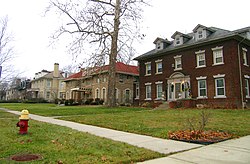Arden Park–East Boston Historic District
Arden Park–East Boston Historic District | |
 | |
 Interactive map | |
| Location | Detroit, Michigan, U.S. |
|---|---|
| Coordinates | 42°23′17″N 83°04′51″W / 42.38806°N 83.08083°W |
| Architect | Multiple |
| Architectural style | Late 19th And Early 20th Century American Movements, Late 19th And 20th Century Revivals, Renaissance |
| NRHP reference No. | 82002891[1] |
| Added to NRHP | April 29, 1982 |
The Arden Park–East Boston Historic District is a
History
The neighborhood was originally platted in 1892 by Joseph R. McLaughlin and Edmund J. Owen along two streets east of Woodward: specifically, East Boston Boulevard and East Chicago Boulevard.[4] and given the name "McLaughlin and Owen's Subdivision."[3][5] The lots were spacious to attract the city's wealthier residents.[6] The subdivision was sold twice before being purchased by Max Broock, a prominent real estate developer, in 1910.[3] At Broock's urging, the name of "East Chicago" was changed to "Arden Park," giving the thoroughfare its present name.[2]


Although the neighborhood was first platted in 1892, most of the homes built in the community date to the first two decades of the Twentieth Century.

Some of the neighborhood's first residents included automotive icons
211 Arden Park was built in 1914 by Hans Gehrke for a renowned jeweler of the time Robert C.J. Traub (until 1911, the Traub Bros. & Co. jewelry store was located where Foran's Grand Trunk Pub is now located in downtown Detroit. The store later moved to the corner of Woodward Avenue and Grand River). The Traub house was featured on the cover of the "House Beautiful" magazine in 1914, as well as every page of that issue featured interiors of the house. This source provided an opportunity for maintaining architecture and interior design of the house in its original state.

The neighborhood's most prominent landmark is the Cathedral of the Most Blessed Sacrament. Next door to the cathedral, is the personal residence of Detroit's Roman Catholic archbishop.
In the 1940s, notable residents included Dr.
Today, the city neighborhood is home largely to professionals, many of whom work in downtown Detroit. The neighborhood is listed on the National Register of Historic Places, the State of Michigan Register of Historic Sites, and is a City of Detroit Designated Historic District.[4]
Schools
Residents are zoned to schools in the
References
- ^ a b "National Register Information System". National Register of Historic Places. National Park Service. January 23, 2007.
- ^ a b c d The Detroit Historic District Commission Archived February 8, 2012, at the Wayback Machine
- ^ a b c d "Arden Park East Boston from Boston-Edison". Archived from the original on February 18, 2008. Retrieved January 8, 2008.
- ^ a b c d Detroit 1701
- ^ Plat map of McLaughlin and Owen's Subdivision[permanent dead link] from the state of Michigan.
- ^ Model D Media Archived October 12, 2008, at the Wayback Machine
- ^ Albert Nelson Marquis, The Book of Detroiters, 1908, A. N. Marquis & Co., p. 312
- ^ Zena Simmons, "Detroit's flamboyant Prophet Jones Archived July 7, 2012, at archive.today," The Detroit News
- Detroit Public Schools. Retrieved on March 30, 2009.
- Detroit Public Schools. Retrieved on March 30, 2009.
- Detroit Public Schools. Retrieved on March 30, 2009.



